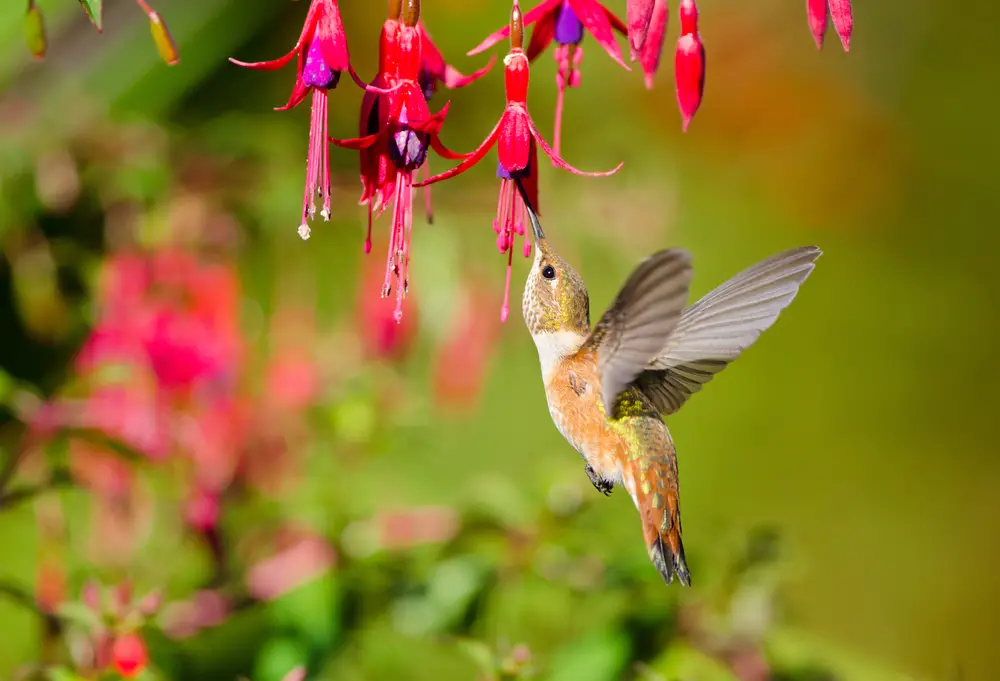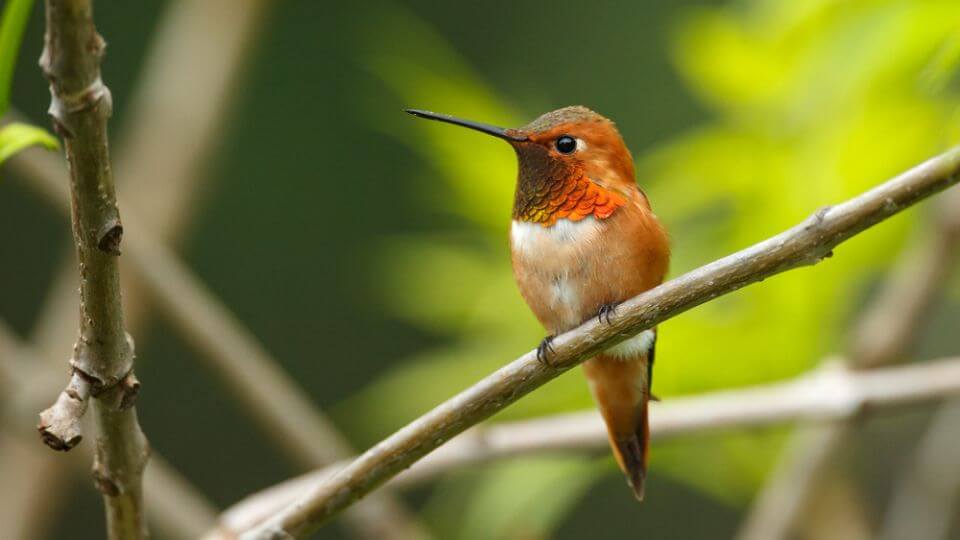Rufous Hummingbirds have a beautiful, rusty orange color. They migrate thousands of miles to their wintering grounds. They actually are one of the most aggressive bird species of hummingbirds in North America. Females build nests wrapped in spider webs, with a maximum of two eggs.
There are so many species of hummingbirds, and each one is special in its own way. Hummingbirds are from the Trochilidae family, which has over 300 species of birds! That’s not a small number of hummingbirds.
Most articles focus on the most common hummingbirds, like the Ruby-throated hummingbird—but many other charming contenders exist. In this article we are going to talk about the Rufous Hummingbird.
Table of Contents
Rufous hummingbird location & migration patterns
Rufous hummingbirds migrate over 3,900 miles from Alaska to Mexico, twice yearly. No other hummingbird travels for such a long distance.
Rufous hummingbirds breed in the summers in Southern Alaska, British Columbia, Canada, and Washington State and Oregon of the Pacific Northwest. After which, they make their fall migration towards the Rocky Mountains.
In spring, they’ll usually hang around in California. During the winter, you can generally see sightings of them on the Gulf Coast. Their habitat is usually open areas with forests and mountain meadows.
Rufous hummingbird appearance
Rufous hummingbirds stand out among other hummingbirds through their appearance and behavior. The adult male rufous hummingbird sports a white belly with rufous sides.
The tail and flanks are also rufous, but they have some green on the back. It has orange tail feathers. Males sport a colorful iridescent rufous gorget that is hard to dismiss.
Female Rufous hummingbirds look duller and don’t have a vivid iridescent throat. Their bodies are usually green and white with rufous spots.
They have some rufous feathers on the throat, albeit significantly less evident than in males. The Rufous hummingbird is smaller than most hummingbird species, but bigger than the Calliope hummingbird.
Rufous hummingbird diet
Rufous hummingbirds typically eat what every other hummingbird eats:
Nectar
These pollinators love to munch on flower nectar. Their favorites are red tubular flowers perfect for their long, impressive bills. You can also make nectar yourself and place it in a
Small insects
Rufous hummingbirds love to eat small insects like gnats, ants, beetles, and spiders. They’re just perfect for that extra protein.
Tree sap
Hummingbirds usually follow woodpeckers to find places where they can enjoy this sweet juice.

Rufous hummingbird facts
The Rufous hummingbird is estimated to have 52–62 wingbeats per second. The wingspan is usually 4-4.5 inches (10 cm). The Rufous hummingbird is in fact one of the most aggressive birds in North America.
More specifically, it tends to be more territorial than other birds. One reason for that could be an insufficient number of food sources. Rufous hummingbirds resemble Allen’s hummingbirds a great deal.
So much so that sometimes it’s hard to tell them apart. You might not see the difference if you’re not a hummingbird aficionado. One key one is that Rufous hummingbirds have rufous backs, while Allen’s have more of a warm green back.
Also, female Rufous hummingbirds can be hard to distinguish from Black-chinned and Anna’s hummingbirds, but the Rufous female has those orange spots that make them stand out.
Rufous hummingbird life cycle
When the breeding season is in full motion, the male will arrive first at the site. This is quickly followed by the female hummingbird.
To impress the females, male Rufous hummingbirds will do courtship displays like U-shaped dives and make loud sounds to attract their attention . They’ll also show off their iridescent gorget.
But don’t get fooled. The male hummingbird does this with many females per breeding season because hummingbirds are not monogamous birds.
The male has no involvement whatsoever. After the season passes, the female hummingbird does everything on her own:
- Nest building
- Incubation
- Taking care of hatchlings
Rufous hummingbird nests
When looking for a spot, hummingbirds prefer to build their nest in coniferous trees or shrubs. When the female builds the nest, she first starts gathering nesting materials like:
- Moss
- Lichen
- Grass
- Twigs
- Leaves
Then she glues it all together using a spider web. The final result is a nest that fits precisely 2 eggs, the maximum number of eggs they can lay in one go. These tiny eggs are the size of a coffee bean and usually take 2-3 weeks to hatch.
After the baby hummingbirds come into the world, they depend entirely on their mother. She roams around, gathers food for her baby hummingbirds, and then returns to the nest to ensure their body temperature is reasonable.
Not long after, fledglings leave the nest and continue this cycle. And so it goes, year after year. The oldest Rufous Hummingbird ever found was 8 years and 11 months old.

Rufous Hummingbird Summary
The conservation status of these rufous jewels is good, but that doesn’t mean that some extra protection would hurt them. Even if they’re not endangered, the number of hummingbirds slowly decreases yearly.
The best way to prevent this is to attract hummingbirds to your garden. Put bird feeders in our gardens and give the pollinators a hummingbird-friendly garden where they can catch small insects.
You can also plant as many native plants as you can, like honeysuckle, bee balm, fuchsia, and cardinal flowers. Ensuring hummingbirds get to live in an environment where they can continue to thrive will help both them as well as us—because pollinators give so much to us.
If you want to have an in-depth understanding of the Rufous hummingbird, check out these sources:
- “Rufous Hummingbird range map by Birds of the World” – Cornell Lab of Ornithology
- “Rufous Hummingbird”- Audubon Guide to North American Birds

